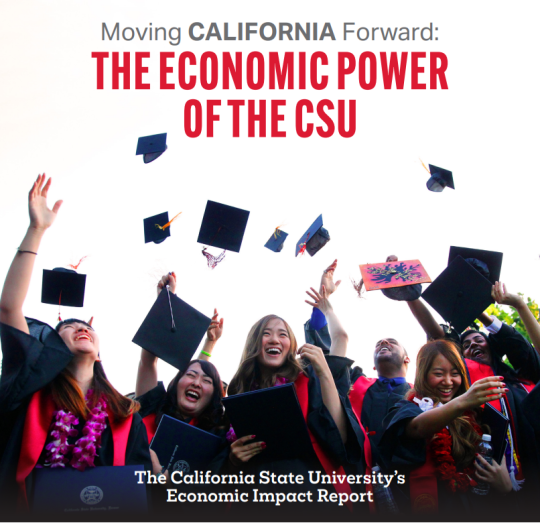SSU, Bay Area campuses fuel region’s economic engine
Sonoma State University and its sister California State University campuses in the Bay Area have a profound effect on the many communities they serve – not just academically and socially, but also economically.
Sonoma State, San Francisco State, San Jose State, and CSU East Bay have a regional impact that supports 31,000 jobs, supports spending of nearly $5 billion by regional employers, and generates $321 million in annual tax revenue, according to a new California State University report.
The report, “Moving California Forward: The Economic Power of the CSU,” divides the nation’s largest public university system into eight geographic areas – Bay Area, Central Coast, Los Angeles, Inland Empire, North Coast, Sacramento Valley, San Diego, and San Joaquin Valley.
The four CSUs in the Bay Area generate $6.59 in revenues for businesses, non-profits and local and state governments throughout California per $1 invested in the 22 campuses by the state of California. This expands to $38.13 per dollar when factoring in alumni earnings from the four Bay Area campuses, a figure 7% higher than the CSU as a whole.
Specific to Sonoma State, the university supports 4,800 jobs in the North Bay, and spurs $487.1 million in regional business and non-profit revenues, including $35.3 million in state and local tax revenues. When enhanced alumni earnings – what a CSU graduate generates in earnings and then spends throughout the state economy – are included, every dollar the state of California invests in SSU translates into $32.35 on the state economy, according to the report. Sonoma State alumni also had higher median incomes attributed to their CSU degrees, supporting 14,000 jobs across California, where those jobs are paid over $1 billion in wages earned, and also generating $231 million in taxes based on taxable transactions, from property to vehicles to restaurant meals.
“As we have seen in previous reports, the CSU and Sonoma State University as a regional example in the Bay Area create amazing support for regional employers and governments for every dollar the state or donors invest, especially once our alumni are creating economic value globally that becomes statewide economic returns,” said Dr. Robert Eyler, a Sonoma State economics professor and senior adviser for community and government relations.
Taken together, the $20 billion spent by the CSU’s 22 campuses spur $31.6 billion in economic activity through business revenues, generate $2.3 billion in state and local tax revenues, and support 210,800 jobs statewide, according to the report. For every dollar that the CSU system receives from the state of California and spends on university operations by paying workers and vendors, the CSU System supports a total of $7.69 in business, non-profit and government revenues throughout California.
When factoring in CSU alumni spending, that return on investment for $1 grows to $35.53. CSU campuses also boost their regional economies because of the goods and services they purchase from their communities and the businesses, non-profits, and workers the 22 campuses support as a system.
Sonoma State is featured in the full report for the College of Education, Counseling, and Ethnic Studies’ teacher residency program, a collaboration of SSU, Mendocino College, the Round Valley Unified School District, and the Redwood Coast K–16 Educational Collaborative. It aims to grow teachers from within the community, engaging individuals who already understand the local culture, language and needs.
The program’s key features and impact:
- Cultural Preservation and Relevance: Residency students are actively involved in preserving the Yuki and Wailaki languages from the Round Valley Indian Tribes, working closely with school leadership to support students and reinforce cultural identity.
- Local Access to Education: Higher education classes are being offered in Covelo, a small rural town in Mendocino County, reducing barriers to access. Students can attend classes locally and travel together to nearby Ukiah for additional coursework.
- Community Empowerment: The program empowers local residents who grew up in Covelo to train to become teachers, transforming residents into leaders and role models.
- Workforce Development: The residency ensures that credentialed teachers are placed in local classrooms, addressing longstanding shortages and improving educational continuity for students.
“Moving California Forward: The Economic Power of the CSU,” also notes that Sonoma State is part of the San Francisco Bay Region Network, an initiative to consolidate core administrative services, finance, HR, IT, construction and security across CSU East Bay; San Francisco State, and Sonoma State. The goal is to deliver high-quality administrative support for less, while preserving each campus’s individual leadership and accreditation. This regional model could serve as a blueprint for future operational innovation within the CSU and beyond.


